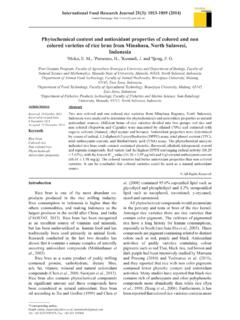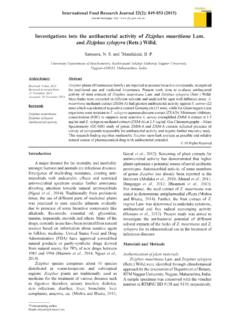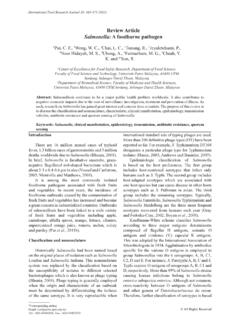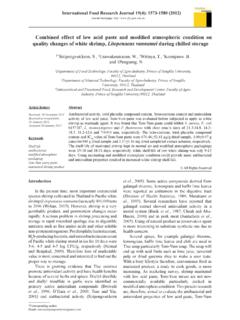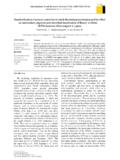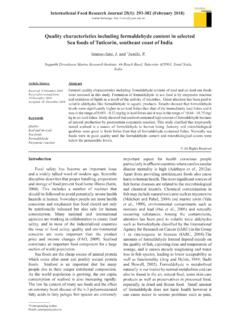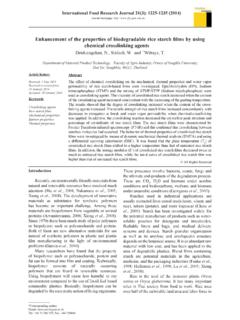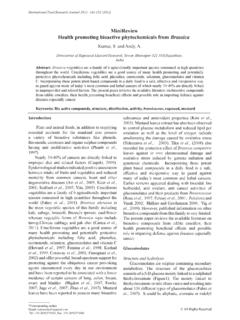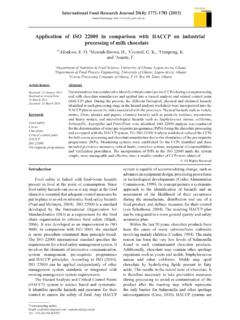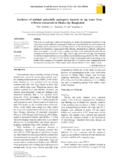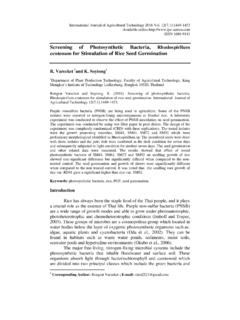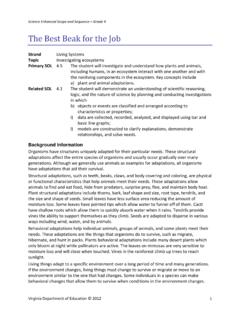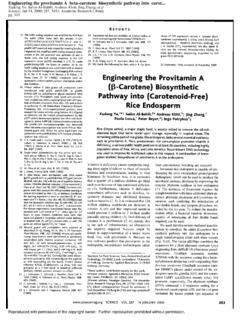Transcription of Morphological, functional and pasting properties of ...
1 All Rights Reserved*Corresponding author. Email: +2348059225829 International Food Research Journal 19(2): 665-671 (2012)*Ashogbon, and Akintayo, of Chemistry, Faculty of Science, University of Ado-Ekiti, NigeriaMorphological, functional and pasting properties of starches separated from rice cultivars grown in NigeriaAbstract: This study was carried out to determine the composition, morphology, functional and pasting properties of rice starches isolated from different rice cultivars (IGR, EAR, ILR and N2R).
2 The starches were isolated from their flours by using a modified deproteination method in NaOH. The highest starch yield of was obtained from EAR with a residual protein of and the lowest starch yield of from IGR with a residual protein of The apparent amylose (AAM) content of rice starches ranged from to rice starches contain , and moisture, fat and ash contents, respectively. The sizes of the starch granules obtained from SEM were between 3-8 m. Some of the granules were individual (single) while others were fused (compound granules).
3 The rice starch granules were polygonal and angular-shaped. When heated from 55 to 95 C at 10 C intervals, starches with higher amylopectin content had higher swelling power (SP). Both SP and water solubility index increased with increased temperature. The bulk density, dispersibility and pH of the rice starches ranged from g/ml, and , respectively. pasting parameters were evaluated using RVA. Significant differences were observed in individual pasting parameters of the rice starches especially in peak viscosity, trough viscosity, final viscosity and setback viscosity.
4 The results revealed that cultivar difference has an effect on composition and pasting properties of rice : rice starch, morphology, dispersibility, functional properties , pastingIntroduction Traditionally, there have been basic attributes associated with rice starch that have given it merit over other cereal and non-cereal starches. These properties include hypoallergenicity, digestibility, bland flavor, small granule (3-10 m), white colour, greater acid resistance, greater freeze thaw stability of pastes and a wide range of amylose/amylopectin ratios.
5 These novel and unique characteristics manifest itself in the different applications of rice are two main polymers in rice starch granules, amylose (AM) and amylopectin (AP). Associated with these are the minor constituents like the proteins ( ) (Baldwin, 2001), the lipids ( ) (Morrison and Azudin, 1987), and the compounds of phosphorus. The rice grains contain four types of proteins (glutelin, prolamin, globulin and albumin) present in the endosperm. They adhere to the surface of the starch and are relatively difficulty to remove.
6 The residual protein of rice starch depends on the method of isolation (Singh et al., 2000). The morphology of starch granules depends on the biochemistry of the chloroplast or amyloplast, as well as the physiology of the plant (Bodenhuizen, 1969). The discrepancy in the size and shape of starch granules is attributed to biological origin (Delcour and Hoseney, 2010). rice starch granules are very small, ranging from 3 to 10 m (Ellis et al., 1998 ) with a unimodal distribution (Dang and Copeland ,2004). They are polygonal and angular-shaped (Singh et al.)
7 , 2003).According to Tester and Morrison (1990), starch swelling is a property of AP, whereas, AM has been known to restrict it (Park et al., 2007; Patindol et al., 2007). For this reason, the difference in swelling and pasting properties among starches should be attributed to variation in AP unit-chain length distribution. Other factors that affect the swelling power and solubility of starch granules are presence of lipids (Galliard and Bowler, 1987) and differences in morphological structures (Singh et al., 2003). pasting encompasses the changes that occur after gelatinization upon further heating and these include further swelling of granules, leaching of molecular components from the granules and eventual disruption of granules especially with the application of shear forces (Tester and Morrison, 1990).
8 The effect of AM and AP on the pasting properties of rice starch has been widely reported( Park et al., 2007; Li et al., 2008). The viscosity parameters during pasting are cooperatively controlled by the properties of the swollen granules and the soluble materials leached out from the granules (Sandhu et al., 2004; Sandhu and Singh, 2007). rice is grown in all ecological and dietary zones of Nigeria, with different species possessing adaptation traits for each ecology. The two commonly 666 Ashogbon, and Akintayo, Food Research Journal 19(2): 665-671grown species in Nigeria are Oryza sativa and Oryza glabberima (Abulude, 2004).
9 Although rice has been the subject of much investigation in the area of basic production in Nigeria, it has not benefited from the kind of value added research required for economic competitiveness on an international scale. Hence, rice producers in the country are small farmers who are left entirely on their own to keep the sub-sector afloat against so many odds. To encourage industrialist to engage in large scale rice cultivation in Nigeria, there is a need for a systematic study that would reveal that functional ingredients can be developed from Nigeria local rice cultivars and that these ingredients would stand the world market competitiveness.
10 One of such functional ingredient from rice is starch. Starch is the major component of rice constituting about 90% of its dry matter (Patindol et al., 2009). Literature review reveals scanty or virtually no information on the composition and the properties of starch derived from local rice cultivars in Nigeria. The existing researches in the literature have been on rice gain itself, effect of parboiling treatments on physicochemical qualities of local rice cultivars in Nigeria (Otegbayo et al., 2001) and chemical composition of the rice grain (Oko and Ugwu, 2011).
